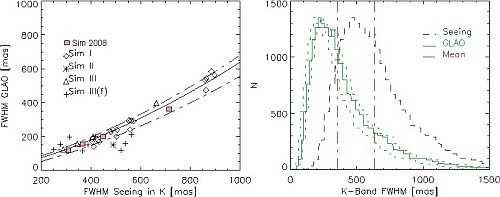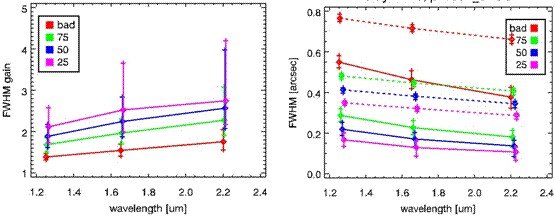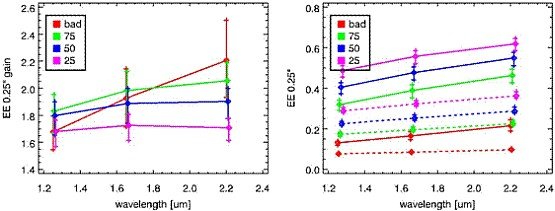Performance

While single conjugated adaptive optics delivers high Strehl ratios on axis, this method generally suffers from angular anisoplanatism. Only a small field over the isoplanatic patch is corrected with the performance quickly degrading toward the edges. Ground layer adaptive optics using multiple laser guide stars is generally capable of correcting a larger field of view. This technique has already been demonstrated with natural stars and recently Rayleigh guide stars at the MMT.
Ground layer adaptive optics offers some general benefits, which are not associated with reaching the diffraction limit. The advantages here lie in the enhanced resolution, the increased point source sensitivity and slit coupling efficiency as well as the robustness against crowding. Offering those benefits over a large field of view makes up the uniqueness to enhance the scientific capabilities of the LBT.
Model calculations show the achievement that can be reached with laser-guided ground layer adaptive optics.
Ground layer adaptive optics offers some general benefits, which are not associated with reaching the diffraction limit. The advantages here lie in the enhanced resolution, the increased point source sensitivity and slit coupling efficiency as well as the robustness against crowding. Offering those benefits over a large field of view makes up the uniqueness to enhance the scientific capabilities of the LBT.
Model calculations show the achievement that can be reached with laser-guided ground layer adaptive optics.

The image on the left shows the gain in FWHM with ARGOS GLAO correction. On the right, you can see FWHM of the corrected PSF (solid lines) and the uncorrected one (dashed). Colors identify the four different atmospheric profiles.

On the left, you can see the gain in ensquared energy with ARGOS GLAO correction. The figure on the right shows the ensquared energy in a 0.25 arcsecond square pixel of the corrected PSF (solid lines) and the uncorrected one (dashed). Colors identify the four different atmospheric profiles defined in [AD1].